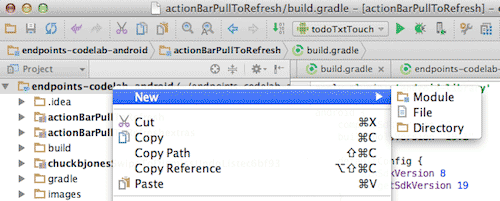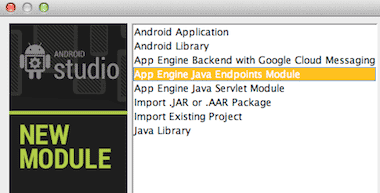Android Studio Backend Templates
The Google Cloud Platform provides backends that can automatically scale up to handle millions of users and that are entirely managed for you, eliminating the need to purchase, configure, maintain or administer servers. Examples of successful Android apps using Google Cloud Platform include Snapchat and Pulse .
Android Studio makes it easy to add a Google Cloud Platform backend to your Android project. You simply choose the type of backend you want and Android Studio adds the required code and dependencies to your project for a functioning, runnable backend that you can easily extend with the features you want, such as data storage.
Android Studio lets you run and test the backend locally and debug it along with your Android app that uses the backend. When you're finished developing and are ready to deploy, you can use Android Studio to deploy your backend to so it can be accessed by users of your app.
Requirements
The Google Cloud Platform backends feature requires the Java 7 SDK. You can check the SDK version used by your project in Android Studio by navigating to File > Project Structure ; the Java version currently being used is displayed in the Project SDK pulldown.
Types of backend templates available
Android Studio provides several types of backend templates for you to choose from:
| Backend Type | Description |
|---|---|
| App Engine Java Servlet Module |
Uses a standard
App Engine Java servlet
, requires the Android client app to build requests and send data using
httpClient
; OAuth is not supported.
|
| App Engine Java Endpoints Module | Uses Google Cloud Endpoints , allows your Android client app to make direct API calls to the backend; OAuth 2.0 support is built-in. |
| App Engine Backend with Google Cloud Messaging | This is similar to App Engine Java Endpoints Module but with the addition of Google Cloud Messaging (GCM) support. GCM lets you provide features such as push notifications to your Android app. |
We expect that most Android developers will use either the Endpoints backend or the Endpoints backend with GCM due to OAuth support and the simpler method of accessing the backend.
Choosing a backend template
In Android Studio, you select the templates as follows:
-
Start Android Studio and open the project for the Android app that needs the new backend.
-
Right-click on your project and select New > Module .

-
Select the desired backend type from the list; for example select App Engine Java Endpoints Module , then click Next :

-
Supply the following information in the New Module form:

- Supply a module name for your backend; this name will be displayed and used in your Android Studio project. If you are adding an existing backend API, you might want to use the name of your API.
- Supply a package name. This package name will be used for all classes imported from this template.
- The client module is the one containing your Android app; it will be automatically selected, so you don't need to change anything here.
- Click Finish to generate the new backend.
-
Select Tools > Android > Sync Project with Gradle Files to sync the project.
At this point, you've created a new buildable and runnable backend module for your Android Studio
project and added it as an additional dependency in your project's
settings.gradle
file.
When you choose one of these template types, a new Gradle module with your specified module/package name will be added to your project containing your new backend. All of the required dependencies/permissions will be automatically set up for you.
Using the templates
For detailed instructions on how to connect your Android app to the backend,
how to debug and test locally, and how to deploy, see the
README
at the
appropriate GitHub repository:
- App Engine Java Servlet Module
- App Engine Java Endpoints Module
- App Engine Backend with Google Cloud Messaging
Suggesting changes or enhance the templates
If you want to make suggestions to improve or enhance these templates, you are welcome to visit the GitHub repo and submit a pull request.
Support
If you have any problems adding these backends to your Android applications, you can find help using the following options:
- Contact us on Android Developers G+ community
- Submit a question on StackOverflow using the google-app-engine or google-cloud-endpoints tags.
For more information
For information on App Engine backends, Endpoints backends, and Google Cloud Messaging, visit the following:
